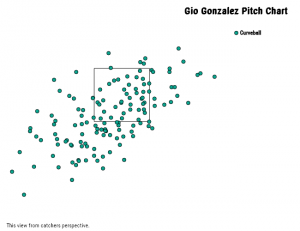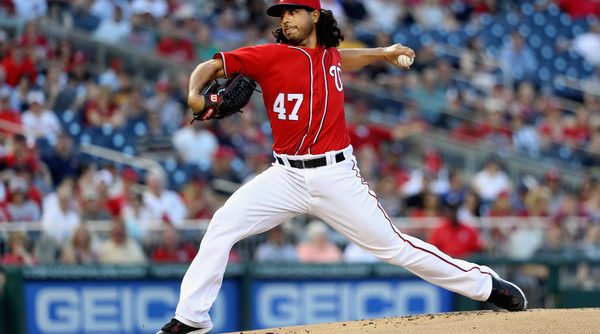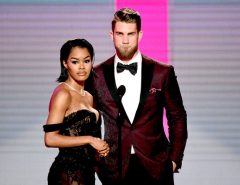Gio Gonzalez came out punching to start the 2016 season. Through his first seven starts, he was on the ERA leaderboard with a 1.93 ERA. His 3.00 FIP and 4.18 xFIP over those seven games, though, indicated that he was unlikely to maintain that stellar ERA. Sure enough, regression hit hard and Gio came crashing back to earth with two back-to-back disastrous starts.
After giving up 13 earned runs to the Mets and Cardinals over only 9 2/3 innings, Gio’s ERA jumped nearly two full points to 3.57 and left Nationals fans scratching their heads, wondering which Gio will show up against the Reds.
Gio’s hot start mostly hid the fact that he had lost a shocking amount of oomph on his fastball. After averaging 92 MPH with the pitch in 2015, Gio has averaged only 90 MPH in this 2016 season. That loss of 2 MPH on the fastball is the largest such decrease in all of baseball among qualified starting pitchers. That’s certainly concerning. But, as I’m sure someone will point out, because Gio had an excellent first seven starts with that diminished velocity, it can’t be fully to blame for the last two terrible outings. That’s fair. The velocity loss isn’t the sole culprit but I believe it’s a major piece of the puzzle. The other piece comes down to the difference between command and control.
The Nationals were able to acquire Gio from the A’s before the 2012 season in part because Gio lacked command and control. During his tenure with the A’s, Gio averaged over four walks per nine innings pitched, meaning he was constantly walking (pun intended) a tightrope with men on base nearly every inning. After the A’s cut bait, something clicked for Gio by coming to the Nats and he hasn’t registered a season with a BB/9 higher than 3.5 since. Gio had turned into a pitcher with command.
What Gio hasn’t learned, though, is control. It’s an important distinction for him. Command usually refers to the ability stay in the strike zone. As an Athletic, Gio struggled to keep his pitches in the strike zone and the result was the sky high walk rate. The Nationals were able to help him hit the strike zone early and often in at bats. After holding a first pitch strike rate in the low 50% range with the A’s, Gio upped that rate to nearly 60% every year with the Nats. Gio now had the command to consistently hit the strike zone.
Despite this improved command, though, no one will mistake Gio for a pitcher with control. While command refers to the ability to throw strikes, control has a more refined definition. A pitcher with control is a pitcher who can pinpoint where he wants to throw the ball. That’s a skill that is still lacking for Gio. Take a look at this pitch chart from Baseball Savant showing where Gio threw his favorite off speed pitch, his curveball:

The pitch has hit just about every part of the strike zone and most of the areas outside of the strike zone for good measure. It’s fair to assume that the curveball that ended up in the middle of the left handed hitter’s batter’s box wasn’t a purpose pitch. And that chart is only for the seven game span where Gio held a sub-2.00 ERA! Even when he was pitching like an ace, Gio wasn’t necessarily hitting his spots. While Gio has learned command he will never be a control pitcher.
And that’s where the loss of velocity comes back into play. The pitchers who withstand velocity losses are the pitchers who can hit their spots on a regular basis. Gio didn’t hit his spots over his first seven games, as his pitch chart can attest to, but he was able to avoid throwing meatballs. In his eighth start versus the Mets, he threw a lot of meatballs. He gave up 10 hits, the most he has allowed in a single outing so far this season, and three home runs. In his next outing against the Cardinals, it looked like Gio hadn’t gotten over the thumping from the Mets. In an attempt to avoid getting hit hard, Gio avoided the strike zone altogether and that resulted in a poor outing. He gave up only six hits against the Cards but issued four walks in 4 2/3 innings of work.
This is the new struggle for Gio. He can still be successful throwing upper 80s with his fastball, but it will be a challenge. When throwing 92 MPH, he didn’t have to be so precise in hitting his spots. Losing two MPH on his fastball means Gio’s margin for error is that much thinner. Gio will have to make a transition from a power pitcher to a finesse pitcher, living in the corners of the strike zone. Gio has already started to refine his approach this season. He’s swapped out some fastballs in favor of throwing his changeup more often. He’s focused on pitching to contact, generating a nearly 50% groundball rate this season after posting a rate over 50% last season. These are the type of changes that can help Gio sustain his success on the mound, even with diminished velocity. No one will ever confuse Gio Gonzalez with Greg Maddux, the king of control, but Nationals’ fans should expect to see Gio bounce back against Reds. Just know his ERA is going to start with a three this year, not a one.
Tags: Gio Gonzalez, Nationals, Nats, Washington Nationals




Leave a Reply